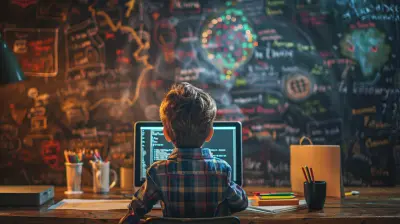Using Real-World Connections to Make Lessons More Engaging
30 June 2025
Let’s face it—getting students excited about lessons these days is about as easy as herding cats. You walk into a classroom ready to drop some knowledge bombs, and half the class is either doodling in their notebooks or trying to solve world hunger (by sharing snacks under the desk). So, how do we rescue learning from the clutches of boredom and bring it back to life?
Drumroll, please… 🥁
Welcome to the wonderful world of using real-world connections to make lessons more engaging. Sounds fancy, right? But trust me—it’s not rocket science (unless you’re actually teaching rocket science, in which case… good luck). In this article, we’re going to break down how tapping into the real world can turn even the most yawn-worthy subject matter into something that makes students sit up and say, “Wait a minute… this actually matters?”
So grab your coffee (or four), kick back, and let’s dive into the magic of making lessons relevant, relatable, and ridiculously fun.
Why Real-World Connections Matter (AKA Why Should I Care?)
You ever try to tell a teenager about the quadratic formula without giving them a reason to care? Might as well be speaking Parseltongue. 🐍Here’s the thing: Students are constantly asking, “When am I ever going to use this in real life?” And honestly, not without reason. If lessons float around in the abstract, students tune out faster than you can say “Pythagorean Theorem.”
But when you tie your lesson to real-world situations—things they encounter in everyday life—they suddenly perk up. They realize that what they’re learning isn’t just some random trivia designed to torture them; it has value. It has purpose. It might even, dare I say it, be cool.
Keep It Relevant: Know Your Audience
You wouldn’t explain Instagram filters to your grandma using TikTok slang, right? Same principle here. To connect lessons to the real world, you’ve got to know what your students are into.Are they obsessed with social media trends? Sports? Video games? Pop culture? Use that. Incorporate those interests into your lessons. If you're teaching probability, maybe use stats from their favorite athlete’s performance. If it's fractions… how about cutting up a pizza?
Think of it this way: If you were trying to sell a pizza, would you do it by listing its ingredients in Latin, or by saying “It’s hot, cheesy, and destined to make your tastebuds party”? Yeah. Sell your lesson like it’s a pizza commercial.
Show, Don’t Just Tell (Please, For The Love of Dry Erase Markers)
Remember those endless lectures you sat through as a kid? The ones where the teacher talked and you nodded while mentally planning your future as a professional ice cream taster?Don’t be that teacher.
Demonstrate what you teach. Bring in real-world examples. Got a lesson on economics? Simulate a classroom market with fake money and let students run their own mini business. Teaching geometry? Measure the dimensions of classroom furniture or the school hallway. Make it tangible. Make it visible. Make it real.
Let your classroom feel like an episode of MythBusters meets The Magic School Bus.
Sprinkle in Some Pop Culture Magic
You know what never fails to grab students' attention? A well-timed pop culture reference. Toss in some Marvel superheroes, trending TikToks, or the latest viral meme and BOOM—you’ve got yourself a captive audience.For instance, teaching narrative structure? Break down the plot of a popular Netflix show. Teaching character analysis? Compare Hamlet to Tony Stark. (Both are dramatic, both need therapy.)
Sure, you might need to do some "research" (read: binge-watching) to stay current, but hey, it’s for educational purposes. Totally legit.
Bring In Guest Speakers (A.K.A. Real-Life Avengers)
Sometimes the best way to connect the lesson to the real world is to bring in someone who actually lives in that world.Imagine a lesson on the environment where a wildlife conservationist Skypes in from the Amazon Rainforest (or, okay, maybe just from their office). Or having an architect explain how geometry influences building design. Instant engagement.
Students love hearing from people who actually do the stuff they're learning about. It helps them see that these abstract ideas aren't just academic fluff—they’re tools professionals use in the real world.
And hey, it’s also a great way to give your voice a break. Bonus!
Technology + Education = Besties Forever
Let’s not fight it—technology isn’t going anywhere. In fact, kids practically have smartphones surgically attached to their hands. Why not use that to your advantage?Use apps, simulations, and interactive games to bring lessons to life. Got a geography lesson? Take a virtual field trip with Google Earth. Teaching financial literacy? There are tons of stock trading simulators out there that let students try their hand at investing—without risking their lunch money.
Tech makes learning dynamic. And honestly, it’s way more exciting than handing out another worksheet.
Project-Based Learning: The Big Kahuna
If real-world connections were a band, project-based learning would be the headlining act. Why? Because instead of just hearing about concepts, students apply them.Assign big, juicy projects that force students to wrestle with real-world problems:
- Build a sustainable city model.
- Design a marketing campaign for a made-up product.
- Create solutions for water shortages in developing countries.
These aren't just “school projects.” They’re mini real-life missions. And students love them because they feel meaningful. It’s learning by doing—and honestly, that's how we all learn best.
Field Trips (AKA The Holy Grail of Engagement)
Let’s be real: if you say the words “field trip,” students suddenly become more alert than if you announced free pizza.But field trips aren’t just about escaping fluorescent lights and hard chairs. They’re real-world connections, wrapped in the excitement of a bus ride.
Visit a science museum, a local business, a courtroom, a newspaper office—any place that connects with your lesson. And if you can’t swing a physical trip, go virtual. There are so many amazing online tours and experiences just waiting to be explored.
Real-World Writing? Oh Yeah, That’s a Thing.
Writing assignments don’t have to be about five-paragraph essays and tired book reports. Give students a reason to write something they might actually encounter in life!- Write a blog post (just like this one!).
- Draft a letter to a company or politician.
- Create a resume or LinkedIn profile.
- Script a podcast episode.
Not only does it pump up engagement, but it also builds real-life skills. Plus, you might be nurturing the next Pulitzer Prize winner or TikTok influencer with a gift for storytelling.
Math Is Everywhere… and We Mean Everywhere
Math often gets the short end of the engagement stick. But guess what? You deal with math every time you budget money, bake brownies, or figure out if that 30% discount is really worth it.Let students plan a party on a budget. Have them calculate interest on imaginary credit card debt. Get them to price out the cost of college (they’ll take math way more seriously after that one).
Show them that math isn’t just numbers on a board—it’s the secret language of everyday life.
Reflection Time: Let Students Share Their Real-World Links
Here’s a zesty twist—let students tell you how your class connects to their lives instead of the other way around.At the end of a unit, ask them to write or discuss:
- “How could I use this knowledge outside of school?”
- “Did anything we learned remind me of something in my life or community?”
Not only does it reinforce learning, but it also gets them to start making those connections on their own. And that's the ultimate goal, right?
The Payoff? Students Actually Care (Cue the Happy Dance 💃🕺)
When you make the effort to anchor lessons in the real world, something magical happens: students stop learning for the test and start learning for life.They become curious. They ask questions. They engage. Why? Because the world isn’t just something they passively observe anymore—it’s a playground of possibilities.
And as a teacher? You get to watch that lightbulb moment happen—and there is nothing better than that.
Final Thoughts: Real-World > Bored World
Using real-world connections to make lessons more engaging isn’t about reinventing the wheel. It’s about rolling that wheel down a path that students actually want to walk on. It’s about making school feel less like a separate universe and more like an extension of everyday life.So whether it’s math, science, history, or literature, ask yourself: “How can I help students see the real-world magic in this?”
Because let’s be honest—when students realize that what they’re learning actually matters?
That’s when the real learning begins.
all images in this post were generated using AI tools
Category:
Student EngagementAuthor:

Zoe McKay
Discussion
rate this article
1 comments
Azriel McCloud
Transforming lessons through real-world connections ignites curiosity and passion in students. By bridging classroom concepts with life experiences, we empower learners to see the relevance of education, fostering engagement and deepening their understanding of the world around them!
July 16, 2025 at 4:28 AM

Zoe McKay
Absolutely! Connecting lessons to real-world experiences not only enhances engagement but also helps students grasp the relevance of their education, igniting their curiosity and passion for learning.


